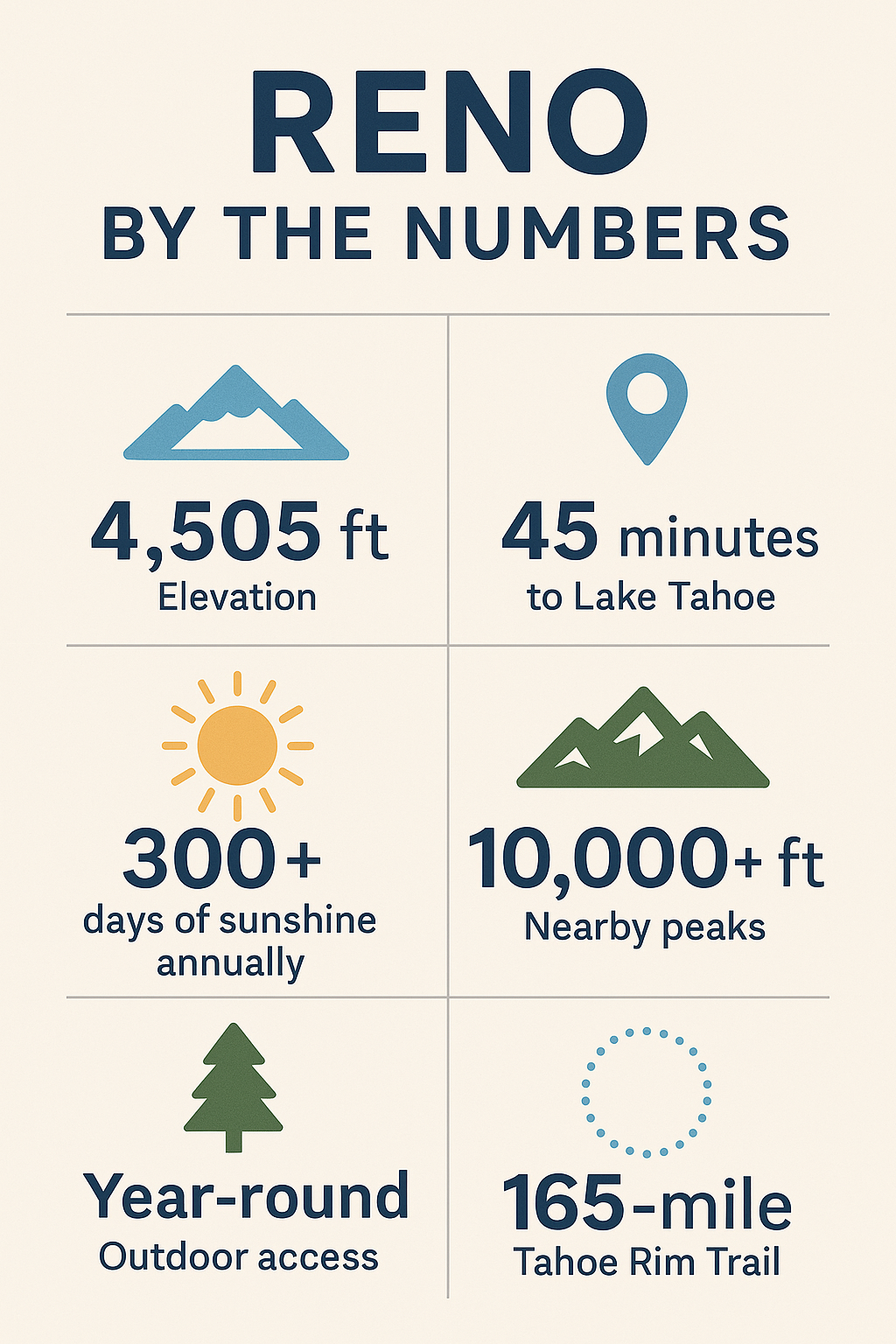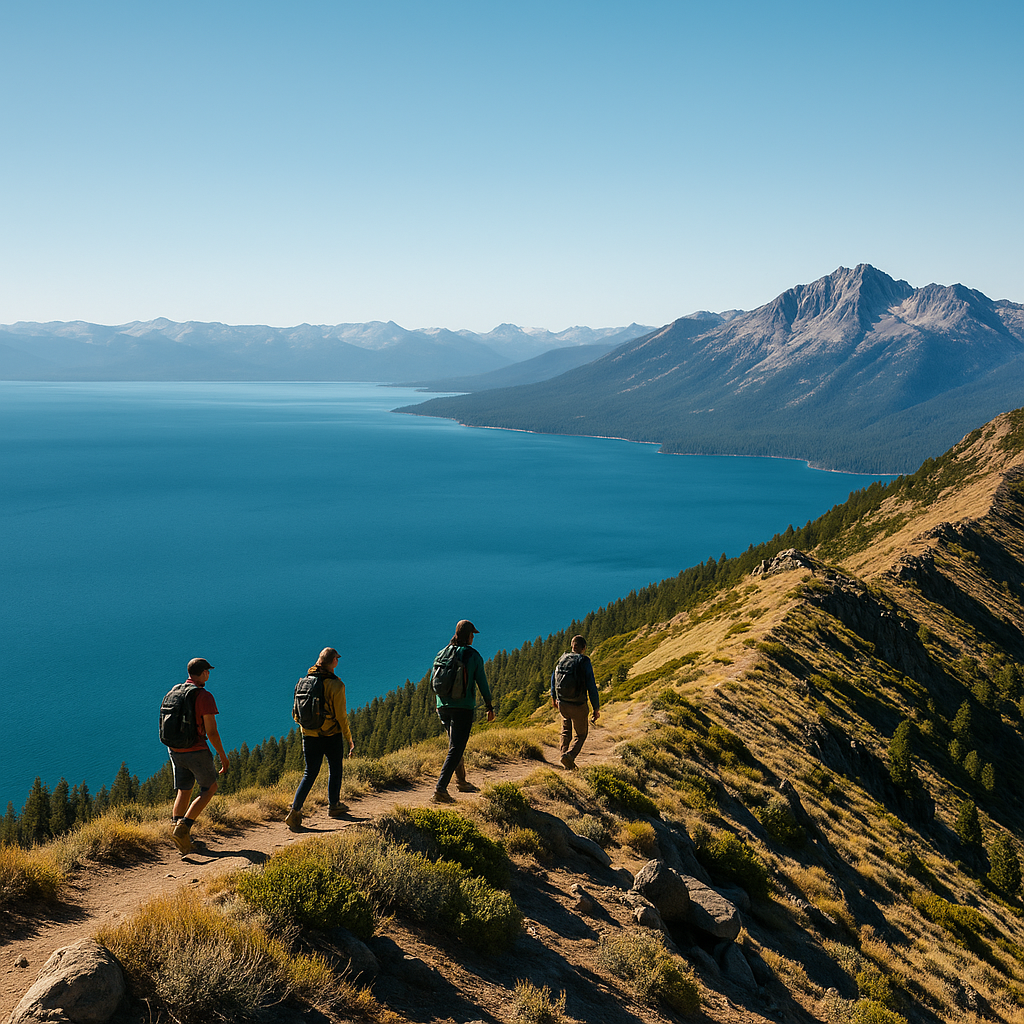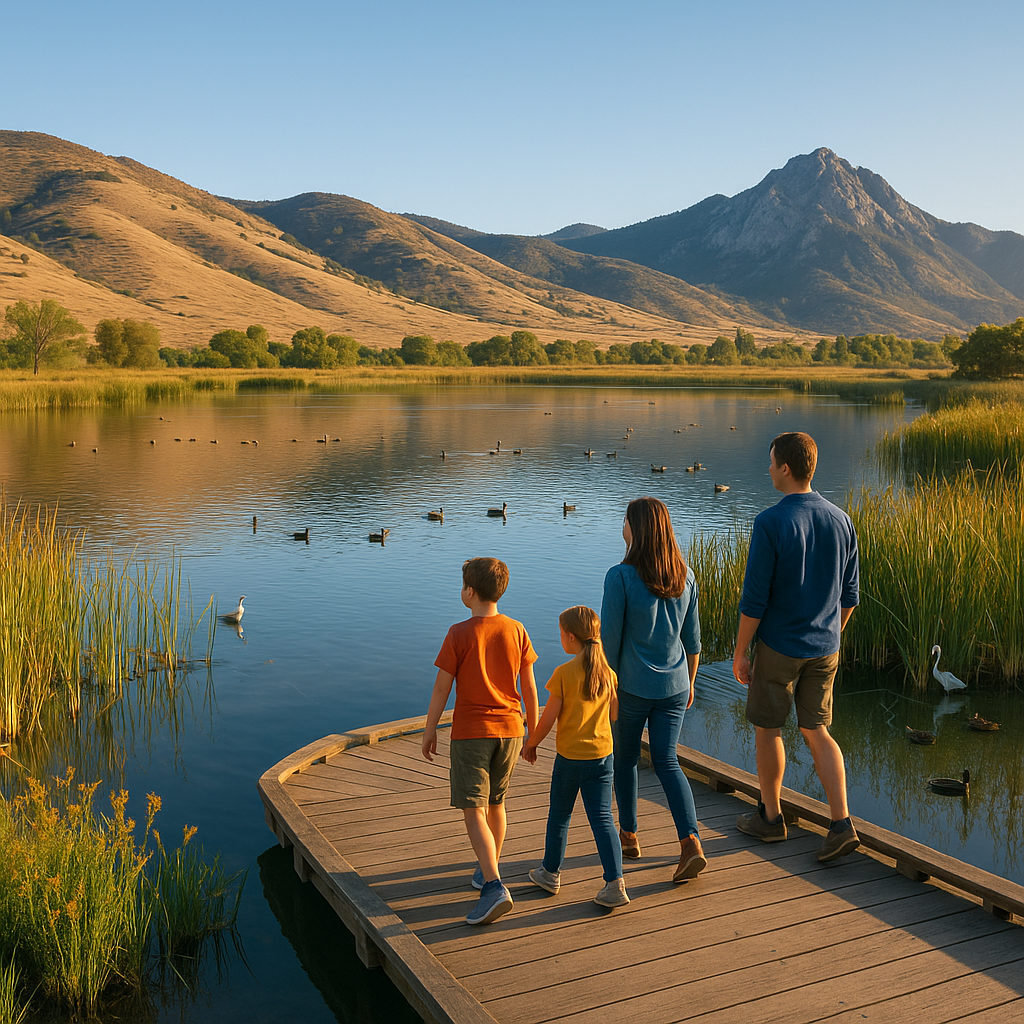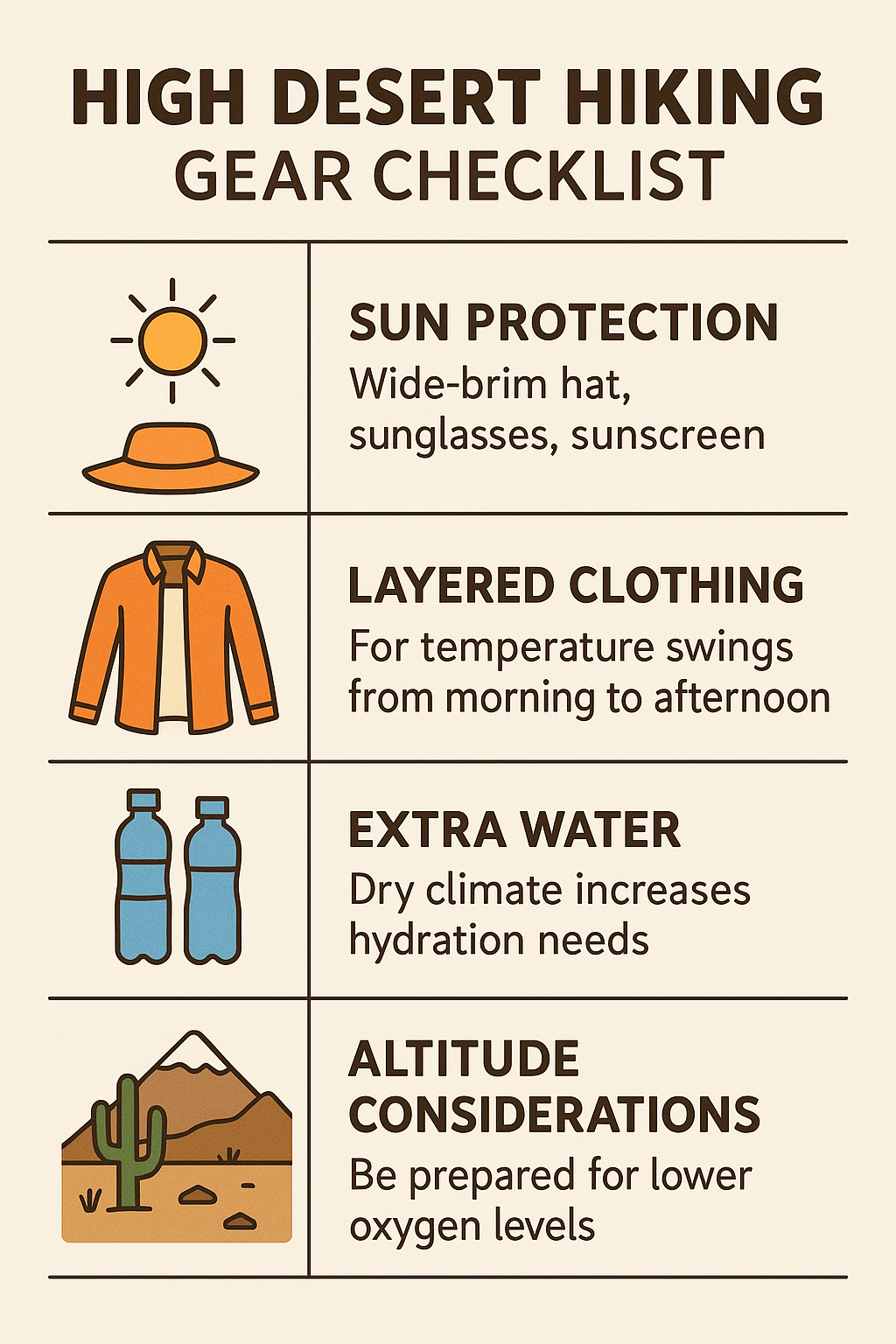The Complete Guide to Sierra Nevada Adventures in America's Adventure Capital
Planning your next outdoor adventure doesn't have to be overwhelming, especially when you're heading to one of America's most uniquely positioned outdoor playgrounds. Reno, Nevada, situated at the eastern foot of the Sierra Nevada mountains and just 45 minutes from Lake Tahoe, offers something truly extraordinary for outdoor enthusiasts of every skill level and interest.
Here's what makes Reno extraordinary: you're positioned at the perfect intersection of high desert terrain, alpine environments, and world-class lake recreation. Whether you're looking to escape the city for a weekend of powder skiing, challenge yourself with technical mountain biking, or experience the crystal-clear waters of Lake Tahoe, this guide will help you make the most of your time in the Sierra Nevada region.

With access to the 165-mile Tahoe Rim Trail, world-class skiing and snowboarding, diverse mountain biking networks from desert single track to alpine adventures, and the pristine waters of Lake Tahoe, Reno truly serves as your basecamp for Sierra Nevada adventures. The city's high desert elevation of 4,505 feet, combined with proximity to 10,000+ foot peaks and one of the world's clearest alpine lakes, creates diverse ecosystems that support an incredible range of activities throughout the year.
HIKING: From High Desert to Alpine Adventures

Getting Started: Desert and Foothills Introduction
If you're new to high-altitude hiking or planning a family adventure, you'll find that Reno offers some of the most accessible mountain and desert hiking in the American West. The unique combination of high desert terrain around the city and nearby alpine environments provides perfect progression opportunities for developing mountain skills.
Local Reno Trails for Skill Building start right in your backyard. Galena Creek Recreation Area offers well-trafficked trails under 2 miles long with moderate terrain, perfect for group hikes or outings with little ones. The area showcases typical Sierra Nevada foothills ecology and provides excellent preparation for more challenging mountain adventures.
The Dorostkar Park Nature Trail offers another perfect introduction at 1.5 miles, featuring interpretive elements that help visitors understand high desert ecosystems and wildlife. What makes this trail special is its gentle introduction to higher altitude hiking—at 4,600 feet elevation, it helps acclimatize newcomers to the thinner air they'll encounter on major mountain adventures.
Here's a pro tip: start these local hikes early in the morning (6:30-8:30 AM) to avoid afternoon heat during summer months and to experience the dramatic lighting effects as the sun hits the Sierra Nevada peaks. The high desert clarity creates photography opportunities that rival any mountain range in the world.
Peavine Peak Trail provides the perfect progression toward serious mountain hiking at 6.2 miles round-trip with 1,400 feet of elevation gain. This local Reno peak reaches 8,266 feet and offers commanding views of the entire Truckee Meadows, Lake Tahoe, and the Sierra Nevada range. The trail demonstrates classic high desert to montane forest transition, showcasing the ecological diversity that makes Sierra Nevada hiking unique.
For families with children, the Swan Lake Nature Study Area provides an excellent introduction to Sierra Nevada ecosystems. This easy loop trail around a small mountain lake involves minimal elevation change and offers wildlife viewing opportunities including waterfowl, small mammals, and diverse bird species adapted to high desert lake environments.

Essential Gear for High Altitude Desert Hiking

What You'll Need for Sierra Nevada Conditions: High altitude desert hiking creates unique equipment requirements different from sea-level or humid climate hiking. The combination of intense UV radiation, dramatic temperature swings, and lower oxygen levels demands thoughtful gear selection even for shorter adventures.
Footwear Guide for Sierra Nevada Terrain:
Trail Runners: Excellent for well-maintained desert and foothills trails, offering breathability crucial in dry climates
Lightweight Hiking Boots: Better for rocky terrain and scree slopes common in Sierra Nevada approaches
Approach Shoes: Ideal for technical scrambling on granite slabs and boulder fields
What to Avoid: Heavy mountaineering boots on desert trails, inadequate sole protection for sharp granite, insufficient ankle support for loose rock
High Altitude Hydration Strategy: At Reno's 4,500+ foot elevation, you'll dehydrate faster than at sea level, and the dry air increases fluid loss through respiration. Plan for 1 liter per 2 hours of hiking as a minimum, with additional water for hot weather and higher elevation adventures. Electrolyte replacement becomes critical during extended summer hiking.
Sierra Nevada Layering System:
Base Layer: Merino wool or synthetic materials that manage moisture and odor during temperature swings
Insulating Layer: Essential for rapid temperature changes with elevation and weather
Sun Protection: Wide-brimmed hat, sunglasses, and long-sleeve sun protection—UV exposure increases dramatically with altitude
Shell Layer: Wind protection becomes critical on exposed ridges and peaks
The Rule: Prepare for 40-degree temperature swings—summer days can range from 30°F pre-dawn to 70°F+ midday
Lake Tahoe Access: World-Class Alpine Hiking
The Tahoe East Shore Trail provides an easy Lake Tahoe hike with plenty of lake views, connecting Incline Village and Sand Harbor State Park on a wide, paved trail. This 3-mile trail offers the perfect introduction to Lake Tahoe's stunning beauty while remaining accessible to hikers of all abilities.
Tahoe's Unique Environment: Lake Tahoe sits at 6,224 feet elevation, creating alpine conditions just 45 minutes from Reno's high desert. The lake's famous clarity—visibility often exceeds 75 feet underwater—results from its depth (1,645 feet maximum), limited nutrient input, and careful environmental protection. This pristine environment provides hiking experiences unlike anywhere else in North America.
Intermediate Lake Tahoe Adventures: The Mount Rose trail offers a combination of wildflowers and a gorgeous waterfall about two miles into the 4.6-mile (one-way) hike. At 10,776 feet, Mount Rose provides the highest vehicle-accessible trailhead in the Lake Tahoe area, making it an excellent introduction to serious alpine hiking.
Eagle Falls and Glen Alpine Falls offer additional waterfall hiking opportunities on Tahoe's south shore. These trails combine granite slab hiking typical of the Sierra Nevada with spectacular water features and lake access. The granite terrain provides excellent preparation for more technical Sierra Nevada adventures while remaining accessible to intermediate hikers.
Advanced Sierra Nevada Challenges
Tahoe Rim Trail Sections provide access to some of California and Nevada's most spectacular hiking. The 165-mile loop trail encircles the Lake Tahoe Basin, offering breathtaking views, diverse terrain, and remote wilderness. The trail's sectional accessibility allows hikers to choose distances and difficulties appropriate to their skill level and available time.
TRT: Mount Rose Summit to Spooner Summit covers one of the trail's most scenic and challenging sections. This point-to-point hike traverses high alpine terrain with sustained elevation above 8,000 feet, multiple peaks and saddles, and commanding views of Lake Tahoe from high Sierra Nevada ridges.
Technical Considerations for Sierra Nevada Hiking: The combination of granite terrain, altitude, and rapidly changing weather creates specific challenges. Route-finding skills become essential as granite slabs may lack obvious trails. Weather awareness is critical—afternoon thunderstorms develop rapidly and can create dangerous conditions on exposed ridges. Physical conditioning must account for reduced oxygen availability at altitude.
Granite Slab Navigation: Much Sierra Nevada hiking involves traveling across granite slabs and domes. Friction hiking requires different techniques than trail hiking—focus on foot placement and balance rather than step-following. Cairn reading becomes an essential skill as routes across granite may be marked only by small rock piles.
Advanced Weather Preparedness: Sierra Nevada weather can change from clear skies to dangerous thunderstorms in less than an hour. Lightning safety becomes paramount on exposed granite—afternoon starts should be avoided during thunderstorm season (July-September). Hypothermia prevention remains important even in summer due to rapid temperature drops with elevation and weather changes.
MOUNTAIN BIKING: Desert Single Track to Alpine Adventures
Reno's mountain biking scene perfectly captures the region's diverse terrain: technical desert single track, flowing foothills trails, and world-class alpine mountain biking around Lake Tahoe.
Local Reno Single Track
Peavine Mountain offers Reno's most extensive local mountain biking with over 30 miles of trails ranging from beginner flow trails to technical expert terrain. The mountain's former ski area provides lift-served opportunities during summer months through Sky Tavern Mountain Bike Park, offering trails and features suitable for riders of all levels, from beginners to seasoned experts.
The Peavine system demonstrates classic Basin and Range mountain biking: high desert terrain with sparse vegetation, granite outcroppings creating technical challenges, and exposed riding requiring weather awareness. The area's 11-month riding season (snow typically limits access only in January-February) makes it a crucial resource for maintaining fitness and skills year-round.
Beginner Peavine Trails include gentle climb routes following old mining and logging roads. These provide excellent introduction to high altitude riding while offering spectacular views of the Truckee Meadows and distant Sierra Nevada peaks. Progressive technical features allow skill development in controlled environments.
Advanced Peavine Challenges include technical descents down loose volcanic rock, narrow ridge riding with significant exposure, and high-speed flow trails requiring advanced bike handling skills. The mountain's 8,266-foot summit is accessible via mountain bike, providing one of the region's most spectacular riding experiences.
Maintenance Considerations for Desert Riding: High desert conditions create specific maintenance requirements. Dust infiltration accelerates component wear, requiring more frequent cleaning and lubrication. Temperature extremes affect tire pressure and shock performance. Sharp volcanic rock increases flat tire risk, making tubeless systems particularly valuable.
Lake Tahoe Alpine Mountain Biking
The Tahoe Rim Trail and Flume Trail offer world-class Lake Tahoe mountain biking with epic views on mellow single-track to burly climbs and exhilarating descents. These trails represent some of the most scenic and technically challenging mountain biking in North America.
Flume Trail provides one of the world's most famous mountain biking experiences. This 14-mile epic combines challenging climbs, technical terrain, and sustained riding along Lake Tahoe's eastern shore at elevations exceeding 7,000 feet. The trail's granite slab sections, exposure, and alpine environment require advanced skills and careful preparation.
Tahoe Rim Trail Mountain Biking Sections provide varying levels of alpine riding challenge. The Tahoe City to Brockway Summit section offers more moderate alpine terrain perfect for intermediate riders wanting to experience high Sierra Nevada single track without extreme technical demands.
Alpine Riding Skills Development:
Granite Slab Riding: Requires different line choices and traction management than soil-based trails
Altitude Adaptation: Reduced oxygen affects performance and recovery at 7,000+ feet
Weather Management: Rapid changes require constant awareness and preparation
Technical Climbing: Sustained grades and loose surfaces demand advanced climbing technique
High Altitude Performance: Lake Tahoe's elevation significantly affects riding performance. Acclimatization requires several days for optimal performance. Hydration needs increase dramatically in dry mountain air. Nutrition strategy must account for increased caloric demands of altitude and technical terrain.
Equipment for Sierra Nevada Mountain Biking
Bike Selection for Diverse Terrain: Reno area riding demands versatile equipment capable of handling everything from desert hardpack to alpine granite slabs. Full suspension bikes provide advantages on technical terrain but may be overkill for smoother desert trails. Hardtails offer efficiency for climbing and work well on hardpack surfaces but struggle with technical granite descents.
Tire Strategy for Variable Conditions: Sierra Nevada terrain requires adaptable tire selection. Desert riding favors faster-rolling compounds and tread patterns that handle hardpack and loose rock. Alpine riding requires more aggressive tread patterns and stronger sidewalls for granite slab navigation and potential off-camber riding.
Protection and Safety Gear: The combination of technical terrain, exposure, and remoteness makes protective gear selection critical. Full-face helmets become appropriate for technical descents and granite slab riding. Knee and elbow protection help with the frequent crashes that occur while learning granite slab technique.
Navigation and Emergency Preparedness: Much Sierra Nevada riding occurs in areas with limited or no cell service. GPS navigation becomes essential for complex trail networks and granite slab route-finding. Emergency preparedness must account for potential long waits for rescue in remote alpine areas.
WATER ACTIVITIES: Lake Tahoe and Regional Adventures
Reno's proximity to Lake Tahoe provides access to some of North America's most spectacular water recreation, from the crystal-clear alpine lake to regional reservoir and river systems.
Lake Tahoe: Alpine Lake Paradise
Lake Tahoe's Unique Characteristics create water recreation opportunities unlike anywhere else. At 1,645 feet deep and 6,224 feet above sea level, Tahoe maintains remarkably consistent temperatures and extraordinary clarity. The lake's 22-mile length and 12-mile width provide diverse conditions from protected coves perfect for beginners to open water challenging enough for advanced paddlers.
Water Temperature Considerations: Even in summer, Lake Tahoe's surface temperatures rarely exceed 68°F, with deeper waters remaining much colder year-round. Cold water safety becomes a primary consideration for all activities. Hypothermia risk exists even during summer months, making appropriate clothing and safety equipment essential.
Tahoe Paddling Opportunities: The lake's size and varied shoreline create paddling experiences ranging from gentle exploration of protected bays to challenging open-water crossings. Sand Harbor State Park provides excellent protected water for beginning paddlers, while Emerald Bay offers more challenging conditions with spectacular scenery.
Stand-Up Paddleboarding (SUP) has become increasingly popular on Lake Tahoe due to the stable platform it provides for enjoying the lake's clarity and scenery. SUP yoga and SUP touring take advantage of Tahoe's calm morning conditions and spectacular surroundings.
Swimming and Beach Access: Lake Tahoe offers numerous public beaches with varying characteristics. Sand Harbor provides sandy beaches and clear, shallow water perfect for families. Secret Harbor offers clothing-optional swimming in a more secluded granite cove environment. King's Beach provides easy access with amenities and lifeguard services.
Regional Water Systems
Truckee River provides the primary flowing water recreation near Reno. The river offers Class I-II whitewater suitable for beginners and families, with several commercial outfitters providing equipment and guided trips. The river's snowmelt-fed nature creates seasonal flow variations, with peak conditions typically occurring during May-July.
Pyramid Lake offers a unique high desert lake experience 35 miles northeast of Reno. This ancient remnant of Lake Lahontan provides excellent fishing, particularly for Lahontan cutthroat trout, and striking desert lake scenery. The lake's alkaline waters and dramatic tufa formations create a landscape unlike typical mountain lake experiences.
Regional Reservoirs including Boca Reservoir and Stampede Reservoir provide additional water recreation opportunities with warmer water temperatures than Lake Tahoe and less restrictive regulations. These reservoirs offer excellent water skiing, wakeboarding, and fishing opportunities during summer months.
Water Safety and Equipment
Cold Water Safety Protocols: Lake Tahoe's cold water requires specific safety preparations regardless of activity. Wetsuit use extends comfortable activity time and provides crucial safety margin. Personal Flotation Devices (PFDs) should be worn by all participants—cold water dramatically reduces swimming ability and survival time.
High Altitude Water Activities: The combination of intense UV radiation and reflection off water surfaces creates extreme sun exposure risks. Comprehensive sun protection including hats, long sleeves, and high-SPF sunscreen becomes essential. Hydration management must account for increased fluid loss at altitude.
Equipment Rental and Access: Lake Tahoe's popularity has created extensive equipment rental infrastructure. Kayak and SUP rentals are available at numerous locations around the lake. Boat launching facilities provide access for private watercraft, though advance reservations may be required during peak season.
GeerGarage Marketplace Water Equipment: The peer-to-peer rental system provides access to specialized water equipment including high-end kayaks, SUP boards, wetsuits, and safety gear. Local equipment owners provide valuable knowledge about current conditions and optimal locations for different activities.
WINTER SPORTS: World-Class Skiing and Snowboarding
Reno's position provides convenient access to some of North America's most diverse and high-quality winter sports, from local community skiing to world-famous Lake Tahoe resorts.
Local Winter Sports Access
Sky Tavern is available for skiing, snowboarding, snowshoeing, and hiking, serving as home of the Junior Ski Program. This community-owned facility provides affordable, accessible winter sports just 30 minutes from downtown Reno. The area's beginner-friendly terrain and community atmosphere make it perfect for families and those new to winter sports.
Sky Tavern Advantages:
Affordable lift tickets and season passes
Excellent learning environment with patient, community-focused instruction
No crowds compared to major destination resorts
Close proximity allows for frequent short sessions ideal for skill development
Community programs including adaptive skiing and youth development
Backcountry Access: Reno's location provides convenient access to extensive backcountry skiing and snowboarding terrain. The Carson Range offers excellent backcountry touring opportunities with varied terrain and spectacular views. Avalanche education and proper equipment become essential for safely accessing this terrain.
Lake Tahoe Resort Access
Northstar California and Mount Rose provide the closest major resort skiing, both within 45 minutes of Reno. These resorts offer diverse terrain, reliable snowmaking, and world-class facilities while remaining convenient for day trips or extended stays.
Mount Rose Ski Resort offers the Lake Tahoe area's highest base elevation (8,260 feet), providing reliable snow conditions and spectacular views of Lake Tahoe and surrounding peaks. The resort's expert terrain includes some of the steepest in-bounds skiing in the region.
Season and Conditions: Lake Tahoe's winter season typically extends from mid-December through April, with March often providing the best combination of snow conditions, weather, and daylight hours. Pacific storm systems provide the primary snow source, creating periods of intense snowfall alternating with clear, cold conditions.
Equipment and Preparation: Sierra Nevada skiing requires equipment appropriate for varied conditions from powder to windpack to spring corn snow. Layer systems must handle dramatic temperature swings. Sun protection becomes critical due to intense UV reflection off snow at high altitude.
Winter Skills Development
Progression Path: Reno's winter sports environment provides natural progression from beginner to expert. Sky Tavern offers perfect learning conditions, local hills provide skill development opportunities, and major resorts challenge advanced skiers and snowboarders.
Specialized Winter Activities: Beyond alpine skiing and snowboarding, the region offers cross-country skiing, snowshoeing, winter hiking, and backcountry touring. Each activity requires specific skills and equipment but provides unique ways to experience Sierra Nevada winter conditions.
SEASONAL ACTIVITIES: Year-Round High Desert Adventures
Reno's high desert location and proximity to alpine environments create distinct seasonal opportunities, with each time of year offering unique advantages and activities.
Spring Adventures (March-May)
Wildflower Season: Mount Rose trail offers wildflowers and waterfalls during spring, representing peak conditions for Sierra Nevada wildflower viewing. The elevation gradient from Reno's 4,500 feet to alpine areas above 10,000 feet creates extended blooming seasons as flowers progress upward with snowmelt.
Transition Season Activities: Spring provides ideal conditions for desert hiking before summer heat becomes oppressive, while snow conditions remain excellent at higher elevations for spring skiing. Water levels peak during snowmelt, creating optimal conditions for whitewater activities on regional rivers.
Weather Variability: Spring weather in the Sierra Nevada can be highly unpredictable, with late season storms creating dangerous conditions at higher elevations while warm, dry conditions prevail in the valleys. Flexible planning and comprehensive gear selection become essential.
Summer Adventures (June-August)
Peak Activity Season: Summer provides optimal conditions for virtually all outdoor activities except winter sports. Long daylight hours (15+ hours during summer solstice) allow for extended adventures. Stable weather patterns make trip planning reliable and safe.
Heat Management: Despite Reno's 4,500-foot elevation, summer temperatures regularly exceed 90°F and can approach 100°F. Early morning starts (5:00-7:00 AM) become essential for desert activities. Alpine escapes to Lake Tahoe and higher elevations provide relief from valley heat.
Water Activity Peak: Summer represents prime season for Lake Tahoe activities, river recreation, and swimming. Water temperatures reach their annual maximum, though Lake Tahoe rarely exceeds 68°F even in late summer.
Fall Adventures (September-November)
Perfect Weather Window: Fall provides ideal weather conditions for most outdoor activities with moderate temperatures, low humidity, and stable weather patterns. Clear air creates exceptional visibility for photography and scenic appreciation.
Aspen Colors: While Nevada lacks the extensive deciduous forests of other regions, aspen groves at higher elevations create spectacular fall color displays. Carson Range and Mount Rose area offer the best local color viewing, typically peaking in late September.
Extended Season: Fall weather often extends well into November, providing opportunities for late season hiking, mountain biking, and water activities while avoiding summer crowds and winter weather preparation.
Winter Adventures (December-February)
Dual Season Opportunities: Reno's winter provides simultaneous access to world-class skiing in the Sierra Nevada and desert hiking in the valley. Temperature inversions often create conditions where valley floors remain clear and mild while mountains receive fresh snow.
Unique Desert Winter: High desert winters offer crystal clear air, dramatic temperature swings, and occasional snow that transforms familiar landscapes. Winter hiking provides access to frozen waterfalls and snow-covered granite formations while avoiding summer heat and crowds.
Equipment Versatility: Winter in Reno requires gear systems capable of handling everything from mild desert hiking to serious alpine skiing often within the same weekend or even the same day.
COMPREHENSIVE GEAR GUIDE: High Desert to Alpine Equipment
Successful outdoor adventures in the Reno area require equipment selection adapted to extreme environmental variability, from hot, dry desert conditions to high-altitude alpine environments.
Climate-Specific Equipment Needs
High Desert Adaptations: Reno's high desert environment creates specific requirements different from both coastal and lower elevation desert climates. UV protection becomes critical due to altitude and clear air. Moisture management must handle dry air that rapidly dehydrates both people and equipment.
Alpine Transitions: The ability to transition from 4,500-foot desert to 10,000+ foot alpine environments within single adventures requires versatile gear systems. Layer compatibility and weight efficiency become paramount when carrying equipment for multiple environments.
Multi-Environment Footwear Strategy
Terrain Diversity Requirements: Reno area activities may involve desert hardpack, granite slabs, scree slopes, snow, and technical rock within single adventures. Footwear selection must balance versatility with performance in primary terrain types.
Seasonal Adaptations: Summer footwear priorities include heat dissipation, UV resistance, and quick drying. Winter footwear must handle snow traction, waterproofing, and insulation while maintaining breathability for high-exertion activities.
Technology Integration
Navigation Reliability: The combination of complex granite terrain, variable weather, and remote locations makes redundant navigation systems essential. Smartphone apps provide detailed information but GPS devices offer longer battery life and more rugged construction.
Communication Planning: Cell service varies dramatically with location and elevation. Satellite communication devices provide crucial safety margin for remote adventures and emergency situations.
Local Equipment Resources
Reno Outdoor Community: The region's outdoor focus has created excellent rental networks, gear swaps, and community knowledge sharing. Local shops provide expertise specific to Sierra Nevada conditions and seasonal requirements.
GeerGarage Marketplace Integration: Peer-to-peer equipment sharing allows access to specialized gear for specific adventures without major investments. Local equipment owners provide valuable route knowledge and condition updates along with equipment access.
SAFETY AND PREPAREDNESS: Sierra Nevada Risk Management
High Altitude Considerations
Altitude Effects: Even Reno's 4,500-foot elevation affects some visitors, while Lake Tahoe activities at 6,200+ feet and mountain adventures above 8,000 feet significantly impact physical performance and safety margins. Acclimatization strategies become important for optimal enjoyment and safety.
Weather Extremes: Sierra Nevada weather can change from benign to life-threatening within hours. Thunderstorm development, flash flooding, and rapid temperature changes create risks requiring constant awareness and appropriate preparation.
Terrain-Specific Risks
Granite Slab Hazards: Much Sierra Nevada terrain involves travel across granite slabs and domes where traditional trail safety doesn't apply. Friction climbing technique, route-finding skills, and fall consequence assessment become essential capabilities.
Flash Flood Awareness: Desert terrain and steep granite watersheds create extreme flash flood potential during storms. Weather monitoring and escape route planning are crucial for activities in canyon and drainage environments.
Emergency Response
Remote Area Considerations: Many quality adventures near Reno occur in areas where professional rescue may be hours away. Self-rescue capabilities, comprehensive first aid skills, and emergency communication become more critical than in urban environments.
Regional Rescue Resources: Washoe County Sheriff's Office, Nevada Division of Emergency Management, and US Forest Service provide emergency response capabilities, but response times and helicopter access are limited by weather and terrain conditions.
